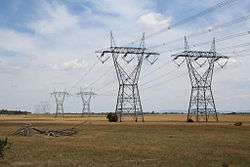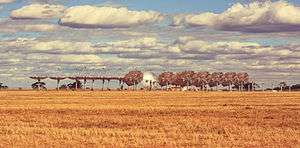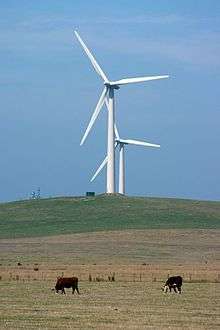Energy in Victoria

Energy in Victoria, Australia is generated using a number of fuels or technologies, including coal, natural gas and renewable energy sources - hydro, wind and solar. Brown coal is the primary energy source in the generation of electricity in the State of Victoria, Australia. Brown coal is also one of the largest contributors to Australia's total domestic greenhouse gas emissions and a source of huge controversy for the country. Australia is one the highest polluters of greenhouse gas per capita in the world. Brown coal is used for the generation of approximately 85%[1] of Victoria's household, commercial and industrial electricity consumption.
History

The first electricity supplies to Melbourne were generated and distributed by a number of private companies and municipal generator and distribution companies. The main municipal-owned power station in Victoria was operated by the Melbourne City Council, which generated electricity from its Spencer Street power station, which opened in 1892, for the city’s residents, as well as being a wholesale supplier to other municipal distributors. The main privately owned company was the Melbourne Electric Supply Company which was established in 1899. The company operated the Richmond power station, which had been opened in 1891, and the Geelong power station.[2] It operated under franchise arrangements with a number of municipal distributors. The final major generator of electricity was the Victorian Railways which operated the Newport power station, for the supply of electricity to Melbourne's suburban trains. Newport power station was the largest power station in the urban area which opened in 1919 close to the mouth of the Yarra River in the inner western suburbs.[3] These early generators all relied on fuel supplies from the strike prone black coal industry of New South Wales.
Early electricity production in Victoria used relatively simple technology, but transmission over even a short distance was difficult. Initially, it was used only for public events - such as the Duke of Edinburgh's visit in 1867 and a night football match at the MCG in 1879 - and lighting in the theatre. Small scale generating plants were built in Melbourne to serve small areas and industries. However, gas remained the fuel for street lighting in Melbourne until 1894, after the construction of the Spencer Street power station by the Melbourne City Council. This power station generated enough power to light Melbourne's streets. Other councils embraced Melbourne's initiative and streets in many nearby areas - such as Richmond, Essendon, Hawthorn and South Yarra - were also lit by electricity by the late 1890s. Some Councils set up their own distribution networks, including Footscray (1911), Brunswick (1912–13), Port Melbourne (1912–13), Preston (1912), Nunawading (1912), Northcote (1912), Coburg (1914), Heidelberg (1914), Williamstown (1915–16) and Doncaster (1916).[4]
The State Electricity Commission of Victoria (SECV) was formed in 1921 to merge these small operations.[b] In the 1920s the SECV investigated hydroelectric power generation, in parallel with work on brown coal fired power stations at Yallourn. In 1922 a report was delivered by Messrs J.M. and H.E. Coane relating to the development of potential hydro-electric power on the Goulburn River and the Cerberean Range; their findings were then in turn submitted to the Parliament of Victoria for funding, with the more cost effective project[5] approved in 1922,[6] and the Rubicon Hydroelectric Scheme commenced in that year. For the first ten years of its operation it supplied on average 16.9% of electricity generated by the SECV.
The SECV took over a number of small municipal electricity distributors during the 1920s, and in the 1930s the Melbourne Electric Supply Company was acquired along with its street tramway operations.[2] Despite these acquisitions, municipal controlled distribution companies known as Municipal Electricity Undertakings (MEUs) in the inner urban areas of Melbourne remained outside of SECV control until the privatisation of the industry in the 1990s.[7]
The first electric tram in Melbourne was built in 1889 by the Box Hill and Doncaster Tramway Company Limited, an enterprise which failed in 1896. Electric trams returned in 1906, with the opening of the Victorian Railways' "Electric Street Railway" from St Kilda to Brighton, and was followed in the same year with the opening of the North Melbourne Electric Tramway and Lighting Company (NMETL) system, which opened two lines from the cable tram terminus at Flemington Bridge to Essendon and Saltwater River (now Maribyrnong River).[8] The NMELT was an electricity and tramway company that operated from 1906 to 1922.[9] The electricity section was taken over by the SECV in 1922.[10] The Melbourne and Metropolitan Tramways Board was formed in 1919 and took over all cable and electric trams in Melbourne. The MMTB extended the electric lines, and from 1924 progressively converted the existing cable system to electric traction.[11] By 1940 all Melbourne cable tram had been converted to electric traction. The electrification of the Melbourne railway network took place in the 1920s.
The SECV built the open cut mine in the Latrobe Valley and opened the first of many brown coal fired power stations in the Latrobe Valley. Yallourn power station was built progressively from the 1920s to the 1960s. Since then the SECV opened two more open cut mines in the valley, feeding power stations at Hazelwood and Loy Yang.
The responsibilities of the SECV were privatised between 1995 and 1999. In 1936, Geelong was connected to the state electrical grid, and by the 1960s Geelong A had closed. Geelong B remained for a few more years being used for peak loads only, but closed in 1970 due to the much higher efficiency of the new power stations in the Latrobe Valley. Richmond power station closed in 1976 and Spencer Street power station closed in 1982. Newport power station closed in the 1980s.[3]
Electricity
Coal fuelled generators

At present, most electricity in Victoria is generated by burning brown coal in thermal power stations in the Latrobe Valley. One of the major electricity consumers in Victoria is the aluminium smelter at Portland.
Unlike many other states, the major coalfields of Victoria contain brown coal, a fuel high in ash and water, and generally unsuitable for combustion without specialized technology. As a result, in the early years of Victoria the state was dependent on black coal imports from New South Wales for its fuel needs.
In the 1920s the Latrobe Valley coalfields began to be exploited for power generation.
Additional brown coal reserves were at Altona, and Anglesea, and black coal in the Strzelecki Ranges in South Gippsland. Both the Altona and Strzelecki Ranges coalfields were small in size, and required underground mining. Production in these mines increased into the early 20th century. The Anglesea coalfield has been mined for Alcoa's Anglesea Power Station since the 1960s, before both the power station and coalfield were shut in 2015.
In 2013-14, the Latrobe Valley produced 98.5% of Australia’s total brown coal production at 57.8 Mt, down from 66.7 Mt in 2001-2
Brown coal has 3 times the climate change and global warming causing GHG emissions per KWh of electricity produced as natural gas. Hazelwood is commonly regarded as the most greenhouse gas polluting power station in Australia. If as is expected after the release of the report of the Garnaut Climate Change Review a cap and trade emissions trading scheme is adopted to reduce the effects of global warming on Australia, electricity produced by burning brown coal will be expected to increase significantly in price. An open cut mine for Hazelwood power plant caught fire, shrouding residents in Morwell with coal dust for about a month Coal mines in Victoria currently operating:
| Mine | Location | Owner | Lat & Long | Type of Coal | Tons Mined PA | Major Buyers | Major Method |
|---|---|---|---|---|---|---|---|
| Yallourn | Yallourn | EnergyAustralia | ? | Lignite | ? | Yallourn Power Station | Open Cut |
| Morwell | Morwell | International Power | ? | Lignite | ? | Hazelwood Power Station, Energy Brix | Open Cut |
| Loy Yang "A" | Traralgon | AGL Loy Yang | ? | Lignite | ? | Loy Yang Power Station | Open Cut |
Hydro

Victoria has a limited hydroelectric power generation system due to the limited water resources.
The Rubicon Hydroelectric Scheme was completed by the State Electricity Commission of Victoria in 1924, and was an important component of the state electrical grid at the time. It was later followed by the Kiewa Hydroelectric Scheme that was constructed between 1938 and 1961, the Eildon Power Station in 1956, Victoria's involvement in the Snowy Mountains Scheme that was built from the 1950s to 1970s, and the Dartmouth Power Station in 1981.
Solar

Small-scale personal, commercial and community roof-mounted systems are becoming more prevalent. A large-scale solar energy project located in Mildura is under construction.
Wind

Trials of wind power in Victoria commenced in 1987, when the State Electricity Commission of Victoria erected a 60 kW capacity Westwind wind generator at Breamlea as a demonstration project. The generator was sold to a private group in 1994 with the privatisation of the SECV.[12] It was not until the early 2000s that the commercial use of wind power for electricity commenced. Wind farms at Codrington, Challicum Hills and Portland were all built by private companies with State Government funding assistance.[13]
By October 2011 there were eight operating wind farms with 428MW of capacity. The development of new wind farms in Victoria became much harder following the election of the Baillieu government who amended the planning scheme in August 2011 to give any landholder within two kilometres a power of veto over a project. This is an unprecedented planning doctrine and according to wind power companies, this change has threatened the viability of investment in the state.[14]
As of November 2016, wind farm capacity had increased to 1,249 MW.[15]
Briquettes
Due to the low energy value of raw brown coal, long distance transport of the fuel was not economic. As a result, the State Electricity Commission of Victoria used German technology to produce hard briquettes from Latrobe Valley brown coal. The initial plant was established in the 1920s at Yallourn, with a second opening at Morwell in the 1940s. These plants crushed, dried and pressed brown coal to extract the water, and form a hard fast-burning block that was easy to transport.
The SECV encouraged the use of briquettes in both industrial and domestic cooking and heating, as a replacement for imported black coal. Briquettes were also used in a number of peak load thermal power stations that were located away from the Latrobe Valley. Briquette usage in Victoria has dropped since the introduction of natural gas to the state, but the Morwell Energy Brix factory continued in operation until August 2014.[16]
Gas
Town gas was initially supplied to Melbourne by private companies such as the Metropolitan Gas Company from the 1850s, and the Brighton Gas Company which was floated in 1877,[17] and others, all of which operated their own small gasworks which converted black coal into gas, with gasworks being scattered throughout the suburbs. Town gas was used for lighting, heating, and cooking, and replaced kerosene for lighting.[17] It was also used for street lighting before electricity became available starting in the 1890s.
The Gas and Fuel Corporation of Victoria was formed in 1951 to manage gas supplies for the state, and to build a centralised brown coal gasification plant at Morwell. The plant opened in 1956 and used the German Lurgi process to produce gas that was transferred to Melbourne via a high pressure gas pipeline.[18]
The production of town gas was changed in the late 1950s when Syngas production was developed, a process that converted waste gases from oil refineries to a useful energy product.[18]
The search for natural gas in Bass Strait off Gippsland commenced in the mid-1960s by Esso Australia and BHP. The floating rig Glomar III was used for exploration drilling, which begun on 27 December 1964. After two months gas was struck, and by June 1965 it was confirmed that a major gas field had been found. Known as the Barracouta field, discovery of the Marlin field followed in March 1966.[19] Both of these fields use offshore drilling rigs as a production base. By 1969 the production plant and distribution network were complete, allowing natural gas to be sold to consumers.[20] A majority of Victoria consumers converting gas appliances to natural gas by the 1970s.[21]
The Gas and Fuel Corporation was privatised in the late 1990s.[22] Today, there are 18 energy retailers in Victoria, 9 of which are also gas retailers.[23]
Additional gas reserves were discovered offshore from the Otway Ranges in recent years. BHP Billiton discovered the Minerva gas field 1993, with production commencing in 2004.[24] The Santos Limited operated Casino field was discovered in 2002, and started production in 2006.[25] In 2002 Woodside Petroleum prepared to develop their Geographe and Thylacine gas fields.[26] These newer gas fields use undersea wellheads connected to the shore and production facilities with pipelines, minimising the visual impact on the coastline.
Today approximately 1.5 million domestic customers in Victoria are supplied with gas via over 25,000 kilometres of mains. Industrial and commercial consumers account for nearly 50% of gas sales.[20] In the 2005/2006 fiscal year, the average gas production in Victoria was over 700 million cubic feet (20,000,000 m3) per day and represented 18% of the total national gas sales, with demand growing at 2% a year.[27]
Oil
Oil was first discovered in the Gippsland Basin under Bass Strait by Esso Australia and BHP in March 1966 in what is now the Marlin field. By early 1968, the Halibut and Kingfish oil fields were discovered nearby. Production from the fields was estimated at up to 300,000 barrels (48,000 m3) per day,[19] with recoverable reserves in the Gippsland Basin in the region of 4 billion barrels (640,000,000 m3).[28]
In 1985, oil production from the Gippsland Basin peaked to an annual average of 450,000 barrels (72,000 m3) per day. In 2005-2006, the average daily oil production declined to 83,000 bbl/d (13,200 m3/d), but despite the decline Victoria still produces almost 19.5% of crude oil in Australia.[27]
See also
- Energy policy of Australia
- Renewable energy in Australia
- Solar power in Australia
- Wind power in Australia
References
- ↑ https://web.archive.org/web/20081007014622/http://www.vecci.org.au/vecci/news+releases/archived+news+2006/mandatory+renewable+energy+targets+impacts+study+needed1.asp. Archived from the original on 7 October 2008. Retrieved 20 December 2008. Missing or empty
|title=(help) - 1 2 Public Records Office: Agency VA 1002: State Electricity Commission of Victoria
- 1 2 "Big expansion planned for Newport". Melbourne: Fairfax Digital, The Age. 13 November 2006. Retrieved 2008-10-05.
- ↑ Lincolne, G 'Electricity Supply in Victoria', p.41
- ↑ "Rubicon Hydroelectric Scheme, Rubicon, VIC (Place ID 100030)". Australian Heritage Database. Department of the Environment. Retrieved 2010-06-02.
- ↑ Gill, Herman (1949). Three Decades: The story of the State Electricity Commission of Victoria from its inception to December 1948. Hutchinson & Co.
- ↑ Malcolm Abbott (March 2006). "The performance of an electricity utility: the case of the State Electricity Commission of Victoria, 1925–93". Australian Economic History Review (Volume 46 Issue 1). Economic History Society of Australia and New Zealand. pp. Pages 23–44. doi:10.1111/j.1467-8446.2006.00150.x. Retrieved 2008-07-25.
- ↑ "The early days". Yarra Trams. Retrieved 26 January 2012.
- ↑ Russell Jones (2005). "A brief history of the North Melbourne Electric Tramway & Lighting Company". Friends of Hawthorn Tram Depot. Retrieved 4 January 2012.
- ↑ "State Electricity Commission of Victoria (previously known as the Electricity Commissioners)". Public Record Office Victoria. Retrieved 4 January 2012.
- ↑ Kathleen Thomson. "Cameron, Alexander (1864–1940)". Australian Dictionary of Biography. Retrieved 4 November 2011.
- ↑ "The History of Community Windfarms". Retrieved 2007-07-19.
- ↑ State of Victoria: Renewable Energy Action Plan Archived 29 August 2007 at the Wayback Machine.
- ↑ "CEC - Victorian wind policy to send jobs and investment interstate". Cleanenergycouncil.org.au. 2011-08-29. Archived from the original on 3 April 2012. Retrieved 2012-06-14.
- ↑ http://earthresources.vic.gov.au/energy/sustainable-energy/wind-energy/wind-projects Wind projects in Victoria, retrieved 25th of November 2016
- ↑ ABC News website Future of Energy Brix power station and briquette factory remains unclear 19 Dec 2014 Retrieved 1 March 2015
- 1 2 Kingston Historical website: The Highett Gasworks
- 1 2 Technology in Australia 1788-1988
- 1 2 Technology in Australia 1788-1988: Discovery in Bass Strait
- 1 2 Energy Safe Victoria: Natural Gas in Victoria
- ↑ Energy Networks Association. "Natural Gas in Victoria". Energy Safe Victoria. Retrieved 2008-10-24.
- ↑ "Privatisation in Australia" (PDF). rba.gov.au/. Archived from the original (PDF) on 2008-07-29. Retrieved 2008-10-05.
- ↑ Energy retail companies - contact list
- ↑ Santos: Minerva field
- ↑ Santos: Casino Field
- ↑ Australian Petroleum Production & Exploration Association: 1997 - 2002 Archived 29 August 2007 at the Wayback Machine.
- 1 2 DEPARTMENT OF PRIMARY INDUSTRIES: Oil and Gas Archived 26 June 2010 at the Wayback Machine.
- ↑ DEPARTMENT OF PRIMARY INDUSTRIES: History of Petroleum Exploration in Victoria Archived 4 October 2007 at the Wayback Machine.
Further reading
- Edwards, Cecil (1969). Brown Power. A jubilee history of the SECV. State Electricity Commission of Victoria.
- Gill, Herman (1949). Three Decades: The story of the State Electricity Commission of Victoria from its inception to December 1948. Hutchinson & Co.
- Jack Vines (2008). "Coal Mining Heritage Study". Heritage Victoria. Retrieved 2010-03-06.